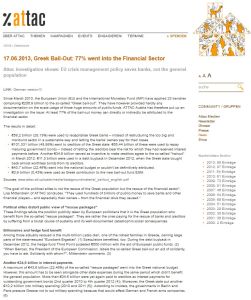Melden Sie sich bei getAbstract an, um die Zusammenfassung zu erhalten.

Melden Sie sich bei getAbstract an, um die Zusammenfassung zu erhalten.
Attac
Greek Bail-Out
77% Went into the Financial Sector
Attac, 2013
Was ist drin?
Most of Greece’s bailout paid off the nation’s creditors and recapitalized its faltering banks.
Recommendation
ATTAC, an organization that campaigns for global justice, takes a dark view of official attempts to save Greece’s moribund economy. The group concludes that Greece didn’t receive a bailout – the nation’s failed banks and creditors did, reaping more than 77% of the crisis funding. Since the purpose of a rescue package is to stabilize an economy and eschew default, chiefly by allowing an economy to pay its debts, the expectation that average citizens would profit may be somewhat naive. Nevertheless, getAbstract, while always politically neutral, believes European policy makers and bankers may be interested in ATTAC’s calls for transparency and reforms.
Summary
About the Author
ATTAC is an international organization that campaigns for global justice.


















Comment on this summary